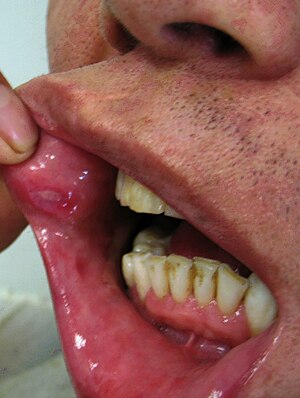Behçet's disease
| Behçet's disease | |
|---|---|
| Synonyms |
|
 |
|
| Behçet's mouth ulcer | |
| Pronunciation | /bɛˈtʃɛt/ |
| Classification and external resources | |
| Specialty | dermatology |
| ICD-10 | M35.2 |
| ICD-9-CM | 136.1 |
| OMIM | 109650 |
| DiseasesDB | 1285 |
| eMedicine | med/218 ped/219 derm/49 oph/425 |
| MeSH | D001528 |
Behçet's disease is a rare immune-mediated small-vessel systemic vasculitis that often presents with mucous membrane ulceration and ocular problems. The disease was named in 1937 after the Turkish dermatologist Hulusi Behçet, who first described the triple-symptom complex of recurrent oral aphthous ulcers, genital ulcers, and uveitis – a disease of the eye. As a systemic disease, it can also involve visceral organs such as the gastrointestinal tract, pulmonary, musculoskeletal, cardiovascular and neurological systems. This syndrome can be fatal due to ruptured vascular aneurysms or severe neurological complications.
Nearly all patients with Behçet's disease (BD) present with some form of painful oral mucocutaneous ulcerations in the form of aphthous ulcers or non-scarring oral lesions. The oral lesions are similar to those found in inflammatory bowel disease and can be relapsing. Painful genital ulcerations usually develop around the anus, vulva, or scrotum and cause scarring in 75 percent of the patients. Additionally, patients may present with erythema nodosum, cutaneous pustular vasculitis, and lesions similar to pyoderma gangrenosum.
Inflammatory eye disease can develop early in the disease course and lead to permanent vision loss in 20 percent of cases. Ocular involvement can be in the form of posterior uveitis, anterior uveitis, or retinal vasculitis. Anterior uveitis presents with painful eyes, conjuctival redness, hypopyon, and decreased visual acuity, while posterior uveitis presents with painless decreased visual acuity and visual field floaters. A rare form of ocular (eye) involvement in this syndrome is retinal vasculitis which presents with painless decrease of vision with the possibility of floaters or visual field defects.
Optic nerve involvement in Behçet's disease is rare, typically presenting as progressive optic atrophy and visual loss. However, cases of acute optic neuropathy (specifically anterior ischemic optic neuropathy) have also been reported to occur. Optic nerve atrophy has been identified as the most common cause of visual impairment. Behçet's disease may result in primary or secondary optic nerve involvement. Papilledema as a result of dural sinus thrombosis and atrophy resulting from retinal disease, have been characterized as secondary causes of optic nerve atrophy in Behçet's disease.
...
Wikipedia
